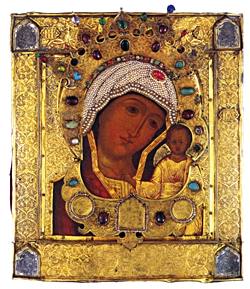

Jewels of the Romanovs - Online Exhibition - return to the Treasures of the Church Thumbnail Menu of Objects

Icon "Our Lady of Kazan"
17th Century
Tempera on panel, pearls, diamonds (.04 carats), rubies (6.4 carats), sapphires (10.56 carats),
garnets (6.6 grams), chrysoprase (.20 grams), chrysolite (.20 grams), glass,
glass beads, gilt metal, silk needlework
12 3/4 x 11 1/4 in (32.4 x 28.4 cm)
Yaroslav State Museum-Preserve
Inv. No. YMZ-7895
There are a number of easily recognizable icon types of the Mother of God, which long ago acquired different descriptive names. The earliest appears to be the Hodegetria, or
"Indicator of the Way", who points toward Christ, while she holds Him in her opposite arm. This type appears in literature for the
first time in the 5th century when the Byzantine Empress Pulcheria placed the original ikon in a special shrine in Constantinople.
The type of Our Lady of Kazan is much later, dating from 1579 when the prototype of the icon was found buried in a garden.
Our Lady of Kazan, or Kazanskaya - as she is called in Russia - rapidly became extremely popular in Russia and cathedrals were dedicated to the icon, such as Kazan Cathedral in St. Petersburg.
The icon, which is covered with an oklad (an ornamental sheet of silver covering the background and frame of the icon)
shows Mary, with her head inclined toward Christ, who holds His hand in blessing. Images of the four evangelists decorate the
corners of the oklad.
 Home | Introduction | Online Exhibition | History | Links | CreditsJewels of the Romanovs - Treasures of the Imperial Court - Website by Pallasart Austin Web Design 
|
|